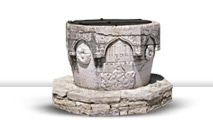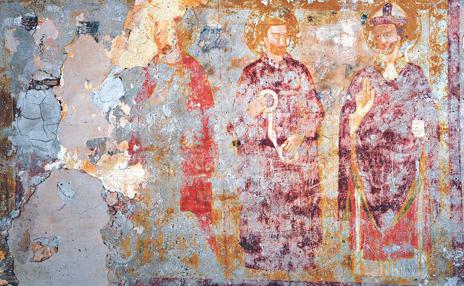
- Gradišće – Koper
- Podpeč – Zanigrad – Hrastovlje
- Slum – Roč – Hum
- Draguć – Paz – Gradinje – Gologorica
- Pićan – Gračišće – Lindar
- Pazin – Beram
- Oprtalj – Čirkoti – Rakotule
- Vižinada – Božje polje – Labinci
- Višnjan – Bačva – Poreč
- Sv. Lovreč – Kloštar
- Šorići – Dvigrad – Kanfanar
- Žminj – Svetvinčenat
- Bale – Batvači – Fažana – Pomer
- Bičići – Barban – Prodol
- Jasenovik – Nova Vas – Vranja
- Plomin – Brseč – Lovran
Šorići – Dvigrad – Kanfanar
Šorići
St. Mary Magdalene
St. Mary Magdalene's Church is situated in the area of former Dvigrad municipality. It stands outside the village, in a field. Architecturally simple, it belongs to the most common architectural typology in Istria, with a semi-circular apse. Such types of sacral edifices are mainly characteristic of the Romanesque in Istria, but were built in the later periods as well. The most important are the preserved frescoes in the church interior: in the apse, on the triumphal arch and parts of the northern and southern walls by the sanctuary. This manner of painting the very sanctuary is commonplace in the Dvigrad area. Its use ranges from the Early Romanesque frescoes in St. Agatha's Church to the Late Gothic walls of St. Mary of Lakuć and St. Anthony's Church near Dvigrad. The conch of the church apse in Šorići depicts the scene of Christ Enthroned surrounded by symbols of the Four Evangelists. In the apse, below Christ, is a row of Apostles. All other painted surfaces depict figures of saints, bearing resemblance to the Holy Trinity Church in Labinci. They also share the same simple system of bordures made of simple lattices and space construction inside the frame. Within the scene the space is marked by the grading of three squares, whereas the saint's haloes cover the upper yellow lattice. Only with this procedure are the figures spatially pronounced. Although their impostations are simple, by the schematic folds on saints' habits completely covering their legs, the painter attempted to avoid the static quality with the position of hands and by the heads of saints rotated in half-profiles. They are recognized only by their attributes. So, on the southern wall we recognize St. Leonardo since he is represented with chains as his peculiar attribute and St. George on a horse slaying a dragon. The frescoes can be dated to the second quarter of the 14th c. Figures reveal Giotto's style processed in the form of stylized art of Rimini and transferred further to Istria. The Giottoesque plasticity completely disappears, whereas the stylization fades into green shades which can best be seen in the circles around the eyes.
Imprimer la page Envoyer a un ami


















